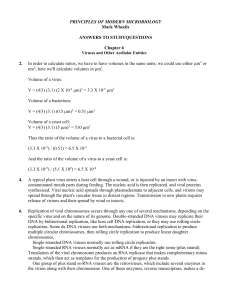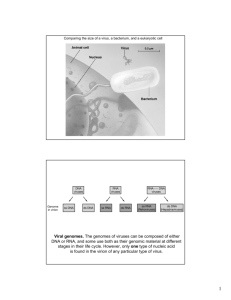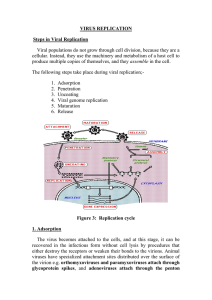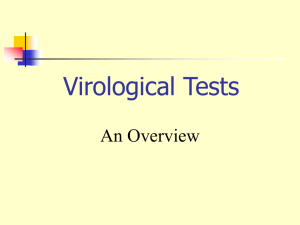Chapter 6 Systems
advertisement
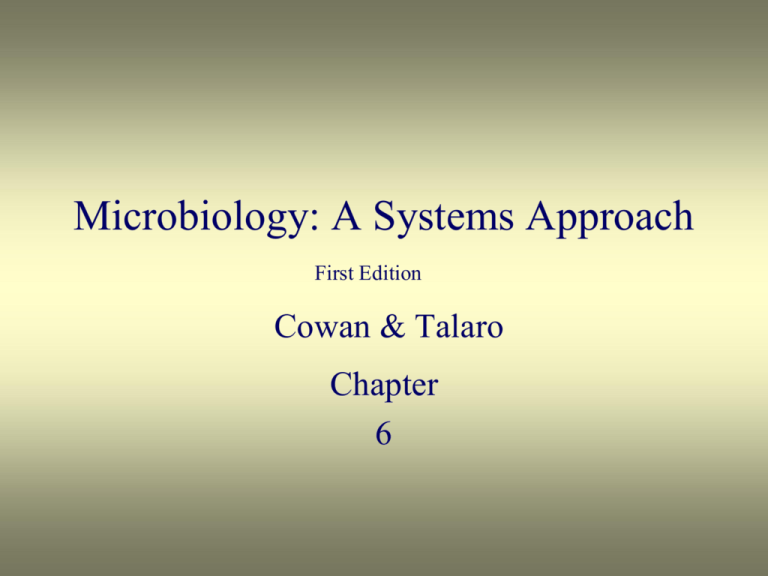
Microbiology: A Systems Approach First Edition Cowan & Talaro Chapter 6 An Introduction to the Viruses Chapter 6 2 3 Size of viruses 4 Naming viruses • No taxa above Family (no kingdom, phylum, etc) • 19 families of animal viruses • Family name ends in ­viridae , Herpesviridae • Genus name ends in ­virus, Simplexvirus • Herpes simplex virus I (HSV­I) 5 • Family – Herpesviridae • Genus – Varicellovirus • Common name – chickenpox virus • Disease ­ chickenpox 6 capsids • All viruses have capsids­ protein coats that enclose & protect their nucleic acid • Each capsid is constructed from identical subunits called capsomers made of protein • 2 types: – helical – iscosahedral 7 helical 8 Animation icosahedral 9 icosahedral • 20­sided with 12 corners • Vary in the number of capsomers • Each capsomer may be made of 1 or several proteins • Some are enveloped 10 complex Fig 6.9a,c 11 6 steps in phage replication 1. adsorption – binding of virus to specific molecule on host cell 2. penetration –genome enters host cell 3. replication – viral components produced 4. assembly ­ viral components assembled 5. maturation – completion of viral formation 6. release – viruses leave cell to infect other cells Video 12 Fig 6.11 13 penetration 14 Bacteriophage assembly line 15 • Not all bacteriophages lyse cells • Temperate phages insert their viral DNA into the host chromosome & viral replication stops at there until some later time. • Lysogeny­ bacterial chromosome carries phage DNA 16 Host range • Spectrum of cells a virus can infect – cell has to have a specific structure (receptor) on its surface for viral attachment – cell has to contain all of the enzymes and materials needed to produce new virions • May be one species or many – HIV (only humans) vs rabies (many animals) • May be one tissue or many within a host – Hepatitis (liver) vs polio (intestinal & nerve cells) 17 Differences between phage and animal virus replication 1. Animal virus replication is more complex than phage replication because host cells are more complex. 2. Animal viruses cannot inject their DNA. 3. Lysogeny for phage, latency for animal viruses 18 Animal virus replication 1. 2. 3. 4. 5. adsorption Video 1 penetration/uncoating of genome duplication/synthesis assembly release Video 2 19 20 adsorption 21 penetration 22 Release by budding 23 Cytopathic effects­ virus­induced damage to cells 1. 2. 3. 4. 5. 6. 7. changes in size & shape cytoplasmic inclusion bodies nuclear inclusion bodies cells fuse to form multinucleated cells cell lysis alter DNA transform cells into cancerous cells 24 Cytopathic changes in cells 25 How do we grow viruses? Obligate intracellular parasites require appropriate cells to replicate. Growing animal viruses 1. live animals 2. bird embryos – chicken, duck; intact, self­ supporting unit, sterile, self­nourished 3. cell culture 27 28 29 Other noncellular infectious agents 1. prions ­ misfolded proteins, contain no nucleic acid – cause spongiform encephalopathies – holes in the brain – common in animals • scrapie in sheep & goats • bovine spongiform encephalopathies (BSE), aka mad cow disease • humans – Creutzfeldt­Jakob Disease 2. viroids ­ short pieces of RNA, no protein coat – only been identified in plants, so far 30 Diagnosis of viral diseases • More difficult than other agents • Consider overall clinical picture • Take appropriate sample – Infect cell culture­ look for characteristic cytopathic effects – Screen for parts of the virus – Screen for immune response to virus (antibodies) 31 diagnosis 32 33


